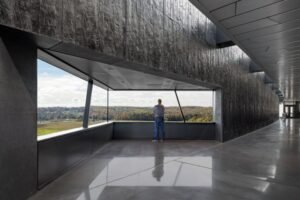Being the second most used material on earth, concrete has an approximate production rate of more than ten billion tonnes throughout the world every year and utilization of as much as 3.5 tonnes per person per year! After its discovery thousands of years ago, it became a prime building material since the 20th century, gaining popularity because of its versatile nature.
Its use in building construction was mainly concentrated around Industrial Architecture during the 19th century but it soon started establishing itself in commercial constructions. The invention and modifications in concrete date back to centuries before modern age concrete was formulated, in the late 1700s.

How does concrete influence Architectural world:
Concrete structures earned their place in the international style of Architecture since the mid-20th century. Although it is a globally used structural material, its use in creating modern and exposed exteriors are limited to public iconic structures.
Its use in modern buildings gives a raw, rich yet sophisticated look to the buildings, proving that concrete has become a part of our skyline and has earned its place in the Architectural and construction fraternity. Concrete overpowers the rather subtly used materials like glass, wood, and steel to build strong and massive structures.
What makes concrete an important material?
- Concrete is an economical material. Compared to other building materials like steel, engineered metals, and composites, the accessibility, and transportation cost of concrete is fairly low.
- Concrete can be molded and cast in various forms. It is this quality of concrete that allows experiments and modeling in designing furniture, artifacts and portable equipment.
- Durable and versatile! Concrete has proven itself by standing tall in extreme temperature, under pressure and is water-resistant.
- Heat resistance capacity of concrete allows it to withstand fire accidents for 3-6 hours or longer depending on the level of exposure to heat. The constituents in concrete allow it to resist heat better than steel and timber.
Working with Architectural concrete:
- Apart from being one of the core building materials, Concrete is used as a surface finish in exterior or interior design. This decorative element can be an elevation treatment or a feature on the facade, for example, GFRC, which is used in most of the exterior applications.
- Mould impressed or form-lined exterior cladding panels also have high design and aesthetic value. These impressions are precast according to a selected pattern and then put together on site.
- The creation of outstanding minimalist furniture pieces in concrete have set an example of the versatility of the material. The most common examples of these can include chairs, countertops, tiles, artifacts, etc.
There are some structural masterpieces in the world which inspired many designers to challenge their creativity and build never seen before concrete miracles. This has been achieved by altering colors, textures and assembling different sizes, shapes, and designs of precast concrete boards.
Discussing the advantages of using Architectural concrete, one of the prominent features of it is its resistance to erosion. It can stand in contact with water as well as in high temperatures and changing weather. The older it gets, the stronger it becomes!
One of the major disadvantages while working with concrete still remains tremendous attention to detailing. Although there are many specialized agencies to handle the job, there needs to be an elaborate study of where and how concrete is being used and the load of the building, etc.

Here is a brief look at some of the most iconic concrete miracles in the world!
- The Pantheon, Italy
The largest un-reinforced concrete dome of this structure still stands tall after almost 2000 years of its construction.
- Falling water, Pennsylvania
The modern architectural icon by Architect Frank Lloyd Wright set a stunning example in reinforced concrete cantilevers and its challenging placement over a waterfall.
- Villa Saitan, Japan
A concrete wall built tall with perforations to imitate a tree and its elements, around this collective housing unit, proved to be an outstanding project by the Eastern design office.
- Church of the Light, Japan
A minimalist concrete structure with crafted details in its ultimate rawness sets itself as a notable work by Architect Tadao Ando.
- Chandigarh Capitol Complex, India
A UNESCO world heritage site, the complex houses three major buildings in its compound. The huge scale of the project, its conception and final result lead it to become an important concrete structure ever to be built in India.

